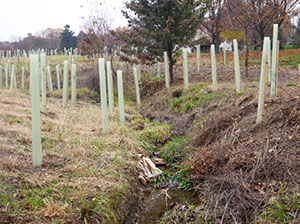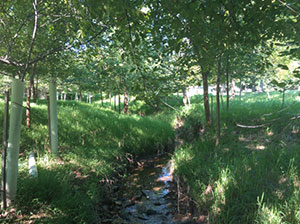Case Study — Lands Preserved by Homeowners Associations
Introduction
Many municipal ordinances require new residential developments to reserve a portion of land for protected open space. Protected open space owned and maintained by Homeowners Associations (HOA) can provide additional value for residents through trails, playgrounds, and protection of sensitive environmental features like forests and stream corridors. It also can serve more utilitarian functions like stormwater management or buffering from adjacent uses.
Location
Throughout Chester County
Total Acreage
Approximately 16,300 acres, or about 12 percent of all preserved open space
Spotlight — Applecross
The Applecross development is located in Guthriesville in East Brandywine Township within an area growing in popularity due in part to its location within the acclaimed Downingtown School District. This 650-home development features a golf course, country club with pool, and 3.5 miles of publicly accessible paved trail within its HOA-owned and operated protected open space. Easily accessible through residents' backyards or by sidewalk, the trail is one of the most well-used amenities within the development and is planned to serve as part of a larger trail network that will connect regional recreation amenities. Additionally, the HOA open space is contiguous with land owned by the Chester County Water Resources Authority and the development's golf course, which enhances the scenic character of the development.
Spotlight — The Knolls of Birmingham
Since 2011, the Homeowners Association of The Knolls of Birmingham development in Birmingham Township has taken a proactive role in stewarding 50+ acres of preserved land within the development. In partnership with the Brandywine Conservancy, volunteers planted and continue to maintain over 1,500 trees and shrubs along the Radley Run, which flows through the development. This planting improves water quality, beautifies the landscape, and provides screening between homes and the development's popular trail network. In the future, the HOA is interested in converting some of its mowed landscape to wildflower meadows to attract pollinators and discourage geese around their stormwater basins to further enhance the protected open space's ecological value.




